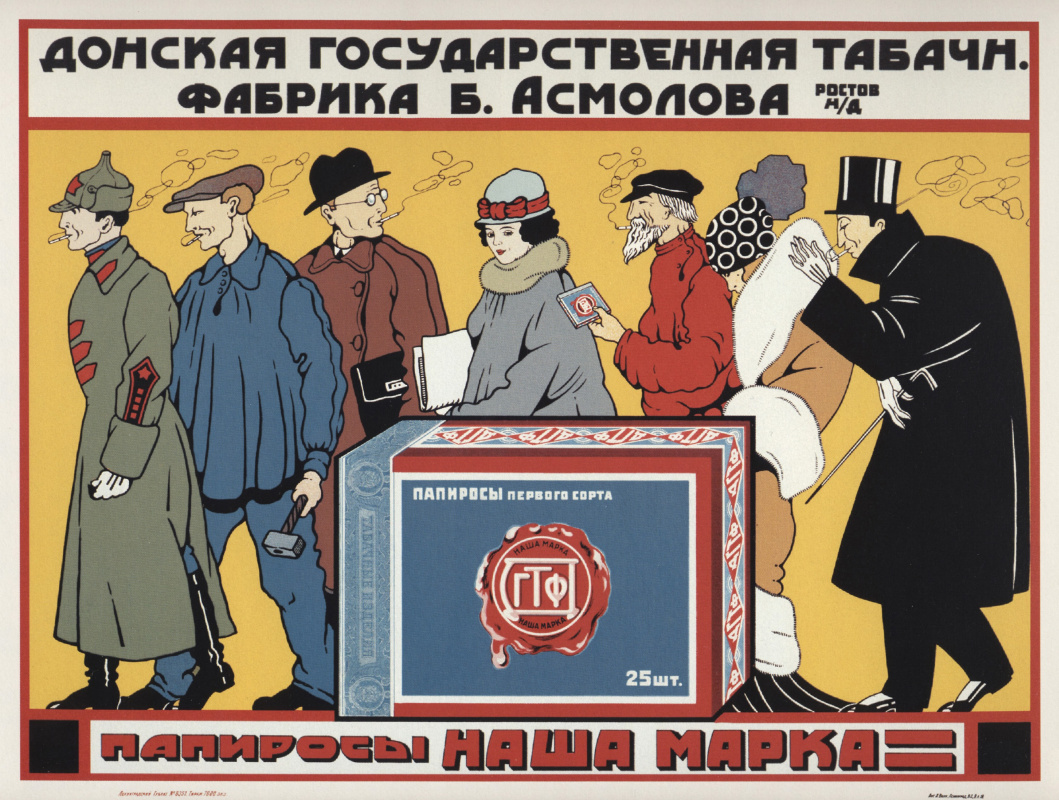Publisher: Raduga (Rainbow)
Author: Agnivtsev, Nikolai IAkovlevich
Artist: Eliseev, Konstantin
Materials:
Colors: Black, Brown, Green, Orange, White
Subjects:
- 1The older woman portrayed here is wearing a traditional village kerchief, a head covering that was associated with female peasants in the early Soviet period that stemmed from a number of traditions. On the one hand, the head covering is religious in nature, referencing the modesty in attire for women principles of Russian orthodoxy. However, by this period the item had been someone de-religionized and instead served to protect the head against the cold, but was likely to be worn by poorer women who could not afford a hat. The red color of the headscarf sticks out on the page, drawing the reader’s eye to it. The cane combined with the scarf forms a familiar image of the wise, elderly “babushka” (grandmother) that appears throughout both Russian and Soviet literature.
- 2This young man is wearing a typical Red Army uniform complete with the budenovka on his head, a cap that was named for cavalry officer and Civil War hero Semyon Budyonny. The cap is said to have been designed by Russian painter Viktor Vasnetsov after the hats of the bogatyr, an epic Russian hero usually portrayed as such. The man’s uniform in this image is also typical of the Red Army, with tall boots, which were important for infantry walking, and a warm jacket which was important for fighting in the subzero winter temperature conditions. These jackets typically had three black stripes with buttons on the front, as this one does.
- 3The formation of this line, consisting of cartoon versions of various types of members of Soviet society, is very reminiscent of a different image from the same period: an advertisement for a brand of cigarettes sold by the “Donskaya” government-operated tobacco company. In the image, seven people are lined up, similar to the way in which these figures are lined up. These people are all united in that they all smoke these cigarettes, despite being from very distinct segments of society. In order from left to right, the advertisement poster features a Red Army soldier complete with a budenovka (analyzed above), a proletariat worker with a hammer in his hand, a member of the intelligentsia (holding a briefcase and wearing glasses), a woman wearing a hat, another working man, and finally followed by a man and a woman from the “capitalist” NEPman class portrayed with a black jacket and top hat for the man and an expensive fur coat for the woman. The following is the image in question:
 Aleksandr Nikolaevich Zelenskii, 1925. Poster of the Donskaia State Tabacco Factory, "Our Brand"
Aleksandr Nikolaevich Zelenskii, 1925. Poster of the Donskaia State Tabacco Factory, "Our Brand" - 4Portrayed with a thick fur hat, luxurious jacket, and as slightly overweight, this man is likely meant to represent a kulak or someone of a similar status. Kulaks were agrarian workers who took advantage of the revolution, similar to NEPmen, in order to expand their personal profits from agriculture and create business-like structures. This group was immensely persecuted and villainized by the state.
- 5The inclusion of this figure highlights the presence of poor and disenfranchised peasants in this society. Portrayed with a cane, missing a shoe, a simple hat (not typical of factory workers but more of beggars or lower level agrarian laborers), older, this peasant is clearly rightfully in need of government assistance, and thus is in this line of inquiries. He, however, is just as important as the other people in the line.
- 6Not visible here is the figure of Kalinin on the following page (click on "View in Book" to see the juxtaposition). Kalinin also appears in Your People’s Commissars at Your House, by the same author (Avgnitsev). Mikhail Ivanovich Kalinin (known to most Soviet citizens as “Kalinych”) was a Bolshevik revolutionary who lived from 1875 to 1946. He served as the Chairman of the Central Executive Committee of the All-Russian Congress of Soviets from 1919 to 1938, the time period during which this children’s book was published.
- 7And is this fair: For Ford to drive around the world While I would fry cutlets? By such Kinds of Reasons Should I suffer innocently?! He is a machine, I am a machine! He goes with gas I go with gas! What is the matter then? - Eh?!
- 8The Russian text plays on the two meanings of "mashina" -- both as car and machine -- as the Primus stove makes his claims to equivalency with the Ford.
- 9He thought, thought, And it came to him: I will go to Kalinin, and I will say If you are above all elders (elder of us all) Figure this one out too, please!


